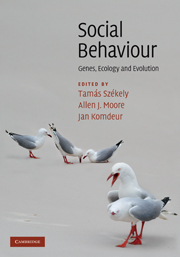Book contents
- Frontmatter
- Contents
- List of contributors
- Introduction: The uphill climb of sociobiology: towards a new synthesis
- Profile: Undiminished passion
- Part I Foundations
- 1 Nature–nurture interactions
- Profile: Social evolution, sexual intrigue and serendipity
- 2 The quantitative genetics of social behaviour
- Profile: Mating systems: integrating sexual conflict and ecology
- 3 Social behaviour and bird song from a neural and endocrine perspective
- Profile: In love with Ropalidia marginata: 34 years, and still going strong
- 4 Evolutionary game theory
- Profile: The huddler's dilemma: a cold shoulder or a warm inner glow
- 5 Recent advances in comparative methods
- Profile: Multi-component signals in ant communication
- 6 Social evolution theory: a review of methods and approaches
- Profile: What's wrong with this picture?
- Part II Themes
- Part III Implications
- Species index
- Subject index
- References
Profile: The huddler's dilemma: a cold shoulder or a warm inner glow
Published online by Cambridge University Press: 05 June 2012
- Frontmatter
- Contents
- List of contributors
- Introduction: The uphill climb of sociobiology: towards a new synthesis
- Profile: Undiminished passion
- Part I Foundations
- 1 Nature–nurture interactions
- Profile: Social evolution, sexual intrigue and serendipity
- 2 The quantitative genetics of social behaviour
- Profile: Mating systems: integrating sexual conflict and ecology
- 3 Social behaviour and bird song from a neural and endocrine perspective
- Profile: In love with Ropalidia marginata: 34 years, and still going strong
- 4 Evolutionary game theory
- Profile: The huddler's dilemma: a cold shoulder or a warm inner glow
- 5 Recent advances in comparative methods
- Profile: Multi-component signals in ant communication
- 6 Social evolution theory: a review of methods and approaches
- Profile: What's wrong with this picture?
- Part II Themes
- Part III Implications
- Species index
- Subject index
- References
Summary
My interest in huddling was aroused by the discovery that GNAS, the locus that encodes the G protein α stimulatory subunit (Gαs), was preferentially expressed from its maternally derived allele in brown adipose tissue of mice (Haig 2004). Since then, additional imprinted genes have been identified with effects on the recruitment and function of brown adipocytes (Haig 2008). The observation that multiple imprinted genes are expressed in brown fat – the principal site of facultative thermogenesis in young mammals – suggests that genetic conflicts over heat transfers among relatives have been a significant selective force in mammalian evolution.
Huddling together for warmth is a simple and widespread cooperative behaviour of inactive birds and mammals (Hill 1992, Forbes 2007). Huddling reduces heat loss from animals that are warmer than their environment by reducing each individual's exposed surface. Moreover, a group can raise the temperature of an enclosed space more effectively than can an individual acting alone. Savings may be substantial. For example, a 10-day-old rat pup in a group of eight consumes 37% less oxygen at 28 °C than an equivalent solitary pup (Alberts 1978).
The fuel consumed by thermogenesis is a direct personal cost to the individual generating heat, but others share in the benefit. Contributors are therefore vulnerable to exploitation by individuals who skimp on their share of the heating bill.
- Type
- Chapter
- Information
- Social BehaviourGenes, Ecology and Evolution, pp. 107 - 109Publisher: Cambridge University PressPrint publication year: 2010
References
- 3
- Cited by



